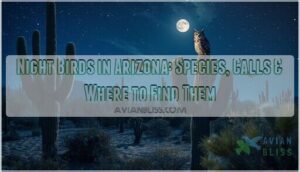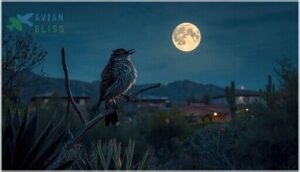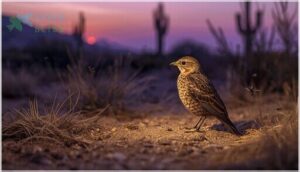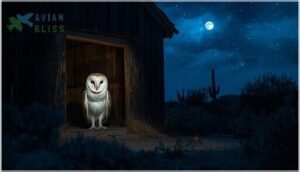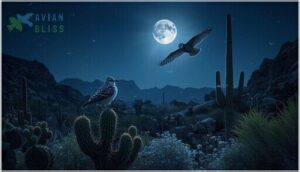This site is supported by our readers. We may earn a commission, at no cost to you, if you purchase through links.
The sun sets over Arizona’s Sonoran Desert, and an entirely different cast of characters takes the stage. While most birds settle in for the night, owls begin their silent patrols, nightjars swoop through the darkness catching insects mid-flight, and even some unexpected songbirds continue their melodies under moonlight.
Night birds in Arizona represent a fascinating world that many people never experience, though these species are actively hunting, calling, and migrating overhead every evening. From the iconic Great Horned Owl perched in a saguaro to the Common Poorwill’s repetitive call echoing through canyon walls, Arizona’s nocturnal avian community includes more than 25 distinct species adapted to life after dark.
Understanding where these birds live, how they communicate, and what makes them successful in darkness opens up entirely new opportunities for observation and appreciation.
Table Of Contents
- Key Takeaways
- Types of Night Birds in Arizona
- Notable Night Bird Species
- Night Bird Habitats and Distribution
- Unique Behaviors and Vocalizations
- Birdwatching Tips for Arizona Night Birds
- Frequently Asked Questions (FAQs)
- What are nocturnal birds in Arizona?
- What birds live in Arizona after dark?
- How to do night birding in Arizona?
- How do I learn nocturnal birds in Arizona?
- What birds chirp at night in Arizona?
- Do nocturnal birds live in the Sonoran Desert?
- What time do Arizona night birds become most active?
- How do night birds navigate in complete darkness?
- What predators threaten Arizonas nocturnal bird populations?
- Can night birds see colors at night?
- Conclusion
Key Takeaways
- Arizona hosts over 25 nocturnal bird species across three main groups—owls, nightjars, and songbirds—each adapted with specialized hunting techniques and distinctive vocalizations that peak between sunset and 3 a.m.
- The state’s diverse habitats, from Sonoran Desert lowlands to mountain forests above 5,000 feet, support different nocturnal communities, with desert shrublands showing the highest diversity during April through September when nightjars and owls dominate 85% of detections.
- Successful night birding in Arizona requires learning to identify calls in the 6-10 kHz frequency range, visiting riparian corridors and Sky Island canyons during peak activity hours, and using red lights with sound discipline to minimize disturbance to these sensitive species.
- Conservation challenges, including habitat loss, light pollution, and declining insect populations, threaten nightjar species particularly hard, making acoustic monitoring through specialized survey networks essential for tracking population trends that traditional counts miss.
Types of Night Birds in Arizona
When the sun sets over Arizona’s deserts and mountains, a whole different cast of birds takes the stage. These night birds fall into three main groups, each with its own hunting style and distinctive sounds.
Let’s look at the owls, nightjars, and songbirds you’re most likely to hear after dark.
Owls Commonly Found at Night
Arizona’s owl species showcase impressive diversity in nocturnal hunting and habitat preferences. You’ll discover these outstanding nocturnal birds across the state’s varied landscapes:
- Great Horned Owl – Arizona’s most common owl, found year-round in desert, urban, and wilderness areas with 46–63 cm lengths
- Barn Owl – Recognizable heart-shaped face, active at dusk in grasslands and agricultural zones
- Burrowing Owl – Inhabits lower deserts around Phoenix and Tucson
- Elf Owl – Arizona hosts 45% of global breeding populations, with 8,500 pairs statewide
These owls are nocturnal raptors, well-adapted for hunting in the dark.
Nightjars and Nighthawks
While owls grab attention, nightjars and nighthawks are Arizona’s quieter nocturnal stars. You’ll encounter four key species—Common Poorwill, Lesser Nighthawk, Mexican Whip-poor-will, and Buff-collared Nightjar—across desert washes, canyons, and pine-oak woodlands. These insect-hunters face serious challenges from habitat fragmentation, insect decline, and light pollution.
As aerial insectivores decline, conservation efforts are increasingly important. Conservation efforts now include specialized survey methods through the Nightjar Survey Network, tracking populations that traditional counts often miss.
| Species | Primary Habitat | Population Estimate |
|---|---|---|
| Lesser Nighthawk | Arroyos, grasslands, urban edges | ~14,000,000 (range-wide) |
| Common Poorwill | Semi-arid slopes, foothills | Large, fragmented populations |
| Mexican Whip-poor-will | Pine-oak woodlands, riparian zones | Monitored regionally |
| Buff-collared Nightjar | Desert washes, canyons | ~2,000,000 (global) |
| Common Nighthawk | Open fields, urban areas | Declining aerial insectivore |
Nocturnal Songbirds
Beyond Arizona’s aerial insectivores, the state is home to over 100 species of nocturnal songbirds, including warblers, sparrows, and thrushes. During the migration season from mid-August through October, monitoring stations record up to 21,000 nighttime flight calls. Acoustic profiles are essential for identifying these night birds, revealing key patterns in their behavior.
Arizona hosts over 100 nocturnal songbird species, with monitoring stations recording up to 21,000 nighttime flight calls during fall migration
- Brewer’s and Clay-colored Sparrows dominate nocturnal passage
- Most calls fall within the 6–10 kHz frequency band
- Peak activity occurs between 21:00 and 03:00
- Southeastern corridors channel concentrated migrations
- Population trends reveal environmental impacts on nightsinging birds
Notable Night Bird Species
Arizona’s nighttime skies come alive with some truly special species, each with its own distinctive calls and behaviors. From the mimicking talents of the Northern Mockingbird to the powerful hoots of the Great Horned Owl, these birds offer unforgettable encounters for anyone willing to listen after dark.
Let’s explore the most notable night birds you’re likely to hear—and perhaps see—across the state.
Northern Mockingbird
You’ll hear this bird’s unmistakable voice long before dawn breaks—the Northern Mockingbird ranks as Arizona’s most talented nocturnal vocalist. Using vocal mimicry, unmated males copy dozens of other species during the breeding season, especially under full moons. Their urban adaptation thrives below 5,000 feet elevation, where territorial defense drives nighttime singing peaks from February through August.
| Characteristic | Details |
|---|---|
| Population Trends | 43-45 million across North America; stable in Arizona |
| Breeding Habits | 2-4 broods annually; nests 3-10 feet high |
| Nighttime Bird Behavior | Males sing after dark during breeding season |
Common Poorwill
You’ll find the Common Poorwill, Arizona’s smallest nightjar, in dry grasslands and desert scrub at elevations from 500 to 2,500 meters. This nocturnal bird weighs just 36-58 grams and produces a distinctive three-note “poor-will-ow” call in the 1.5 kHz range.
Both parents share 20-21 day incubation duties, with stable populations across Arizona earning an S5 conservation status.
Lesser Nighthawk
You can spot the Lesser Nighthawk across Arizona’s deserts and shrublands, where its barred brown-and-tan plumage provides perfect desert camouflage. This nocturnal bird becomes active during crepuscular activity periods at dusk and dawn, when it:
- Opens its wide mouth to catch flying insects mid-flight
- Emits a low, tremolo whirring call that’s hard to locate
- Nests directly on bare ground without building a structure
Arizona hosts about 14 million of these summer visitors from April through October before their migration patterns take them to Central America.
Great Horned Owl
Arizona’s Great Horned Owl stands as the state’s largest owl species, with a wingspan reaching 4.5 feet and unmistakable ear tufts. You’ll recognize its deep, territorial hoot echoing through deserts, mountains, and even Phoenix neighborhoods where urban owls have adapted remarkably well.
| Characteristic | Details |
|---|---|
| Hunting Strategies | Nocturnal predator using acute hearing; captures rodents, reptiles, scorpions |
| Nesting Habits | Uses abandoned hawk/crow nests; breeds January-February |
| Owl Adaptations | Specialized low-light vision, 3-inch talons, camouflage plumage |
| Distribution | All Arizona regions—deserts, forests, urban areas |
| Conservation Status | Least concern; stable population of 5.7 million across North America |
These nocturnal birds control pest populations naturally, making them essential to Arizona’s ecosystem health.
Barn Owl
With its ghostly heart-shaped face and piercing screech, the Barn Owl stands out among Arizona’s nocturnal birds. You’ll find this efficient hunter throughout agricultural valleys and southern deserts, where its feeding ecology centers on rodents—sometimes capturing 2,000 mice yearly.
Key features include:
- Nesting habits utilizing cavities, barns, and artificial boxes
- High-pitched screams for vocalizations and territory defense
- Population trends showing habitat loss concerns despite conservation efforts
Mexican Whip-poor-will
You’ll recognize the Mexican Whip-poor-will by its haunting, three-syllable call echoing through Arizona’s pine-oak woodlands. This rare nightjar faces population decline from habitat loss, particularly wildfire damage affecting 1.8 million acres. With only 320,000 individuals globally, its conservation status demands attention.
| Characteristic | Details |
|---|---|
| Vocalizations | Low-pitched “whip-poor-will” calls |
| Diet | Moths and beetles caught mid-air |
| Habitat Loss Impact | 1.8 million acres burned in Gila Forest |
| Conservation Status | 2016 State of Birds Watch List |
You’ll find these nighttime birds hunting insects near mesic canyons with surface water, where 87% of Arizona detections occur.
Black-crowned Night-Heron
You’ll hear the Black-crowned Night-Heron’s distinctive barking call near Arizona’s wetlands, where these nocturnal birds feed primarily on fish but adapt their diet to include crustaceans and amphibians.
Despite a stable conservation status, pollution threats and habitat loss—over 50% of wetlands lost—affect their breeding colonies.
These night birds roost in groups, sometimes exceeding 6,000 nests, making them essential indicators for Arizona birdwatching enthusiasts monitoring wetland health.
Night Bird Habitats and Distribution
Arizona’s night birds don’t stick to just one type of landscape—they’re spread across the state’s incredibly diverse terrain. From scorching desert flats to cool mountain forests, each habitat nurtures its own unique mix of nocturnal species.
Let’s look at the three main environments where you’re most likely to encounter these after-dark aviators.
Desert and Shrubland Environments
Across Arizona’s Sonoran Desert, you’ll encounter the highest diversity of nocturnal birds during April through September, when nightjars and owls account for nearly 85% of nighttime detections.
Habitat structure matters—over 80% of desert night birds select areas with dense, tall shrubs for nesting.
Species like the Lesser Nighthawk and Common Poorwill thrive in open washes and bajadas, where foraging patterns focus on aerial insect hunting.
Mountain and Forested Regions
Climbing Arizona’s mountain forests above 5,000 feet, you’ll find over 25 nocturnal birds thriving across elevation gradients. Species richness peaks in the Chiricahua and Santa Rita ranges, where oak-pine woodlands shelter Flammulated Owls, Mexican Whip-poor-wills, and the rare Buff-collared Nightjar.
Seasonal migration brings these forest specialists from April through October, making nighttime birding exceptionally rewarding for birdwatching enthusiasts tracking conservation status trends.
Urban and Riparian Areas
Arizona’s cities and river corridors reveal surprising nocturnal bird diversity. Phoenix riparian zones host 21.6 species per survey, with Black-crowned Night-Herons appearing at 80% of urban wetlands.
Streetlights boost nighthawk activity by 45% near water, while habitat restoration increases night bird occurrence by 41%.
Northern Mockingbirds average 23 songs per hour along urban streams, making these accessible hotspots essential for nighttime birding adventures.
Unique Behaviors and Vocalizations
Arizona’s night birds aren’t just active after dark—they’ve developed fascinating ways to communicate, hunt, and defend their space. From the Northern Mockingbird’s midnight concerts to the stealthy hunting tactics of owls, these behaviors reveal how each species has adapted to life in the darkness.
You’ll discover how these birds use their voices and instincts to thrive when most other creatures are asleep.
Nighttime Singing and Calling
When darkness falls over Arizona, nocturnal birds transform the night into an acoustic symphony. You’ll discover that their nighttime calls serve specific purposes, creating a complex communication network across desert and mountain landscapes.
Key aspects of nocturnal wildlife vocalizations include:
- Call functions – Territory defense and mate attraction drive 79% of breeding interactions among Arizona’s nocturnal birds
- Vocalization timing – Northern Mockingbirds peak between 1 a.m. and 4 a.m., while Common Poorwills begin their “poor-will” notes at dusk
- Environmental impact – Monsoon humidity doubles evening chorus frequency compared to dry conditions
- Species dialects – Individual mockingbirds perform over 200 distinct song types nightly, mimicking other bird chirps and environmental sounds
- Monitoring acoustics – Automated recording devices detect up to 30 unique night bird calls during spring migration peaks
Hunting and Feeding Patterns
When the sun sets, Arizona’s night birds switch into hunting mode with striking precision. Owls like the Great Horned use perch-and-pounce tactics, spending 10-15 minutes per attempt.
Lesser Nighthawks achieve 68-85% foraging efficiency during peak insect emergence, while Common Poorwills target moths and beetles that make up over 80% of their diet.
Urban influence extends foraging time by 15-30% where artificial lights concentrate prey.
Communication and Territory Defense
Vocalization patterns shape how night birds defend their space in Arizona’s darkness. You’ll hear Mexican Whip-poor-wills repeating their namesake call, while Spotted Owls peak in vocal activity during the two hours after sunset. Duet defense strengthens territorial responses, with pairs showing more coordinated aggression than solo birds.
Species strategies reveal fascinating communication methods:
- Common Poorwills mark boundaries with distinctive “poor-will” calls throughout the night
- Elf Owls select cavity-rich saguaros to boost territorial announcements
- Lesser Nighthawks use brief “peent” calls to communicate status in shrublands
- Male Spotted Owls vocalize more intensely than females during territorial intrusions
- Nocturnal songbirds produce over 20,000 flight calls in 72 nights
Temporal effects matter markedly—moon phase and post-sunset duration influence call timing. Acoustic mapping through monitoring stations tracks these bird chirps, documenting territorial overlap across Arizona’s migratory corridors.
Birdwatching Tips for Arizona Night Birds
Spotting night birds in Arizona takes a little know-how, but you’ll be amazed at what you can discover once you know where to look and listen. Learning to identify their calls is your first step, followed by visiting the right habitats at the right time.
We’ll also cover how to watch responsibly, so you can enjoy these nocturnal species without disturbing their natural behaviors.
Identifying Night Bird Calls
You’ll recognize most night birds in Arizona by their distinct vocal signatures. Northern Mockingbirds deliver piercing calls during mating season, while Common Poorwills repeat their namesake “poor-will” sound. Lesser Nighthawks produce rhythmic “peent” notes.
For reliable bird identification, listen for call frequency ranges between 6–10 kHz. Acoustic monitoring methods, including automated recording units and spectrographic analysis, help distinguish owl species and other nocturnal bird species with precision.
Best Locations for Night Birding
Arizona’s Sky Island canyons deliver remarkable nighttime birding opportunities, with Madera Canyon supporting over 250 documented bird species.
Riparian migration sites along the San Pedro River host over 20,000 nocturnal migrants nightly during peak seasons.
Desert parks like Cave Creek Regional Park record up to 9 nocturnal species per spring night.
Organized tours in southeast Arizona consistently encounter 6+ target species, with seasonal variation peaking April through July.
Responsible and Ethical Birdwatching Practices
You’ll protect Arizona’s night bird species when you minimize disturbance through red-light use and sound discipline during nighttime birding.
Habitat respect means staying on trails and maintaining 50-meter buffers from owl habitat and behavior zones.
Proper equipment use—telephoto lenses over close approaches—reduces stress on bird species.
Community engagement through responsible birdwatching strengthens conservation across Arizona’s diverse nocturnal populations.
Frequently Asked Questions (FAQs)
What are nocturnal birds in Arizona?
Nocturnal wildlife in Arizona includes owls, nightjars, and songbirds.
These bird species possess specialized sensory biology and nocturnal adaptations that let them hunt and communicate after dark, fulfilling essential ecological roles in desert and mountain ecosystems.
What birds live in Arizona after dark?
You’ll find over 15 owl species hunting after dark in Arizona, along with nightjars like poorwills and nighthawks.
Desert birds dominate, but urban night birds and migratory nightbirds also fill Arizona’s nocturnal wildlife soundscape.
How to do night birding in Arizona?
While most birders pack away their binoculars at dusk, you’ll need gear essentials like headlamps and recording equipment to identify Arizona’s nighttime behavior of birds through distinctive calls and ethical location scouting practices.
How do I learn nocturnal birds in Arizona?
Start birding with local experts who can teach you nocturnal bird identification resources and nighttime safety.
Study calls using audio guides, understand nighttime behavior of birds, and follow ethical considerations during your birdwatching in Arizona adventures.
What birds chirp at night in Arizona?
You’ll hear Northern Mockingbirds mimicking dozens of bird calls, Common Poorwills with their distinctive “poor-will” songs, and Lesser Nighthawks producing rhythmic “peent” calls during Arizona’s desert night chorus.
Do nocturnal birds live in the Sonoran Desert?
Yes, you’ll discover thriving nocturnal behavior among Desert Birds in the Sonoran Desert, Arizona. Five primary Night Birds—including Elf Owls and Lesser Nighthawks—have evolved impressive Species Adaptation despite Conservation Challenges like Habitat Loss and Light Pollution affecting Desert Nightlife.
What time do Arizona night birds become most active?
While darkness seems to slow the world down, nocturnal animals like night birds actually ramp up their activity.
Most Arizona species peak during the two hours immediately following sunset, when insects emerge and hunting conditions align perfectly.
How do night birds navigate in complete darkness?
Night birds rely on magnetic field detection, celestial cues like star patterns, and olfactory senses to navigate darkness. Their circadian rhythms guide nocturnal animals through migration, though artificial light increasingly disrupts these nighttime adaptations and wildlife behavior.
What predators threaten Arizonas nocturnal bird populations?
While Arizona nocturnal birds face natural Raptor Predation from Great Horned Owls, Mammalian Threats like coyotes and Invasive Predators including feral cats pose greater risks.
Human Impacts through Habitat Loss and vehicle collisions greatly threaten these vulnerable wildlife populations.
Can night birds see colors at night?
Most nocturnal birds can’t distinguish colors in darkness. Rod-dominant retinas increase light sensitivity but sacrifice color vision. Evolutionary pressures favor achromatic contrast over multifocal optics, making nighttime avian behavior largely color-blind.
Conclusion
Most people think darkness signals the end of birdlife, yet Arizona’s night birds prove that’s when the real action begins.
You’ve now got the tools to identify calls, understand behaviors, and locate these exceptional species across desert, mountain, and urban habitats.
The next time you hear an owl’s hoot or a nightjar’s repetitive song echoing through the darkness, you won’t just listen—you’ll recognize exactly which bird commands the night sky above you.

